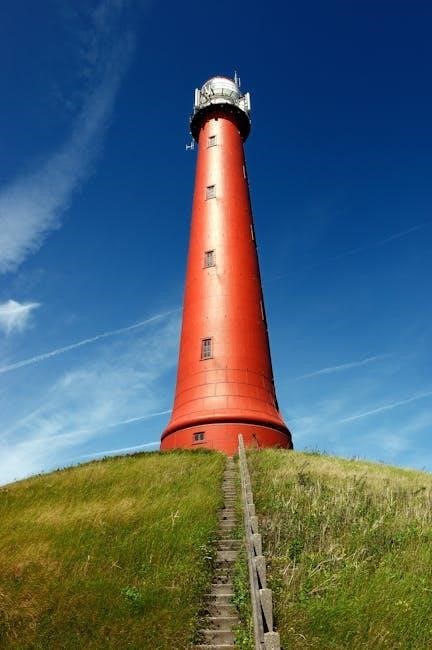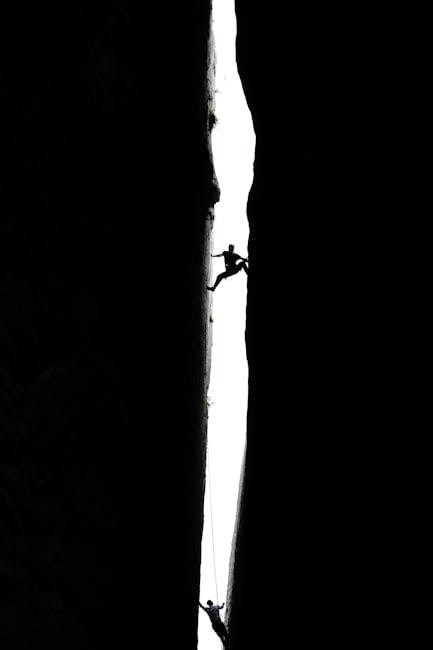rope guide
- Published
- in Guide
Climbing ropes are your lifeline, designed to absorb falls and provide safety. They come in dynamic and static types, each suited for specific climbing disciplines and conditions.
Importance of Climbing Ropes
Climbing ropes are the most critical piece of safety gear in climbing, serving as your lifeline during ascents. They are designed to absorb the impact of falls, reducing the force transmitted to the climber. A high-quality rope ensures reliability, durability, and performance across various climbing disciplines. Whether sport climbing, trad climbing, or ice climbing, the right rope adapts to the demands of the terrain and conditions. Its proper selection and maintenance are essential for ensuring safety and extending its lifespan, making it a vital investment for every climber.
Basic Rope Types: Dynamic vs. Static
Climbing ropes are categorized into dynamic and static types, each designed for specific purposes. Dynamic ropes stretch to absorb energy during falls, making them essential for lead climbing and belaying. Static ropes, in contrast, have minimal stretch and are ideal for rappelling, rescue operations, and fixed-line ascents. Dynamic ropes prioritize shock absorption, while static ropes focus on stability and control. Understanding these differences is crucial for selecting the right rope for your climbing needs and ensuring safety in various climbing scenarios and conditions.

Dynamic Climbing Ropes
Dynamic ropes stretch to absorb energy during falls, enhancing safety for climbers. They are essential for lead climbing and top-rope setups, providing critical shock absorption and durability.
Key Features of Dynamic Ropes
Dynamic ropes are designed to stretch and absorb energy during falls, reducing impact force on the climber. Made from nylon, they offer exceptional elasticity and durability. These ropes feature a kernmantle design, with a durable outer sheath and a shock-absorbing core. They are available in various diameters (7-11mm) and lengths (30-80m), catering to different climbing styles. Their flexibility and resistance to abrasion make them ideal for lead climbing and top-rope setups, ensuring both safety and performance in dynamic climbing situations.
Best Uses for Dynamic Ropes
Dynamic ropes are essential for lead climbing, top-rope setups, and belayed ascents where fall absorption is critical. They excel in sport climbing, trad climbing, and big wall climbs, providing the necessary stretch to reduce impact force. Their versatility makes them ideal for both indoor and outdoor climbing. A 60m rope is standard for most routes, offering enough length for typical pitches while ensuring ease of handling. They are also preferred for their durability and resistance to abrasion, making them a reliable choice for climbers across various disciplines.
Stretch and Fall Absorption
Dynamic ropes are designed to stretch under load, absorbing the energy of a fall to reduce impact force on the climber. This elasticity, provided by the kernmantle construction, allows the rope to temporarily elongate, dissipating the shock. The core absorbs the energy, while the sheath protects it from abrasion. Longer ropes are often used in outdoor climbing to ensure coverage for route lengths, enhancing safety and performance. This stretch is critical for providing a softer catch, making dynamic ropes indispensable for belayed climbing and fall protection.

Static Climbing Ropes
Static ropes do not stretch under load, making them unsuitable for lead climbing. They are used in industrial, caving, and sailing applications, as well as fixed lines in mountaineering. Their core-sheath design ensures durability, with a focus on stability rather than energy absorption, making them ideal for scenarios where dynamic movement is not required. However, they are not designed for fall protection in belayed climbing situations.
When to Use Static Ropes
Static ropes are ideal for applications where minimal stretch is critical, such as caving, sailing, and industrial tasks. They are commonly used for fixed lines in mountaineering, rescue operations, and scenarios requiring stability. Static ropes are not suitable for lead climbing but excel in situations where durability and resistance to abrasion are paramount. Their rigid design makes them perfect for ascending fixed lines with mechanical devices, ensuring a secure and controlled movement in harsh or specialized environments. Always choose static ropes for non-dynamic, stability-focused tasks.
Industrial and Specialized Uses
Static ropes are widely used in industrial settings and specialized applications. In rescue operations, they serve as reliable fixed lines for lifting and lowering personnel. In sailing, they are employed for rigging and securing loads. Their durability and resistance to abrasion make them ideal for caving and canyoneering. Additionally, static ropes are used in construction for stabilizing equipment and in arboriculture for tree climbing. Their versatility and strength ensure they are indispensable in various non-climbing, high-stakes environments where stability and reliability are crucial.

Rope Length and Diameter
Dynamic ropes for climbing range from 30m to 80m, with 60m being the standard. Diameter options are 7-11mm, with 9.8mm being the most common choice for durability and ease of use.
Standard Rope Lengths for Climbing
Standard climbing rope lengths range from 30m to 80m, with 60m being the most common choice for outdoor climbing. This length ensures it can cover most routes, as it’s double the length of many pitches. For indoor climbing, shorter ropes (30-40m) often suffice due to shorter routes. When selecting a rope, consider the longest pitch you’ll climb; your rope should be at least twice the pitch length. Longer ropes (70m or more) are ideal for extended routes or deep descents, offering extra versatility for varied climbing needs.
Choosing the Right Diameter
Climbing ropes range in diameter from 7mm to 11mm, with most climbers opting for 9.5mm to 10.5mm. Thicker ropes (9.8mm and above) are more durable and easier to handle, making them ideal for top-roping and big wall climbing. Thinner ropes (below 9.5mm) are lighter and suitable for sport or lead climbing. The diameter affects both durability and handling, so choose based on your climbing style, frequency, and the type of routes you’ll tackle to ensure the right balance between weight and longevity.
Thickness and Durability Trade-offs
Climbing ropes vary in thickness, with diameters ranging from 7mm to 11mm. Thicker ropes (9.8mm and above) are more durable, resistant to abrasion, and easier to handle, making them ideal for frequent use and heavy loads. Thinner ropes (below 9.5mm) are lighter and more flexible but may wear out faster. The trade-off lies in balancing weight, longevity, and performance. Choose a thickness that aligns with your climbing frequency, route type, and personal preference to optimize both safety and efficiency.

Modern Rope Construction
Modern climbing ropes feature a kernmantle design, combining a durable outer sheath and a shock-absorbing inner core. This construction enhances safety, durability, and performance for various climbing conditions.
Kernmantle Design
The kernmantle design is a revolutionary construction method for climbing ropes, consisting of a durable outer sheath and a shock-absorbing inner core. Introduced by Edelrid in the 1960s, this design revolutionized climbing safety by providing dynamic stretch to absorb falls and reduce impact force. The core, made of twisted nylon strands, offers elasticity, while the sheath protects against abrasion and environmental factors. This balance of strength and flexibility makes kernmantle ropes indispensable for modern climbing, ensuring both safety and durability across various conditions.
Core and Sheath Layers
Climbing ropes feature a core and sheath design, where the core provides dynamic stretch to absorb falls, while the sheath protects the core from abrasion and environmental factors. The core is made of nylon strands twisted together for elasticity, and the sheath is woven tightly around it for durability. This layered construction ensures the rope remains flexible and resistant to wear, balancing safety and performance for various climbing conditions and disciplines.
Materials Used in Rope Manufacturing
Climbing ropes are primarily made from nylon, known for its strength and elasticity. The core consists of nylon strands twisted for dynamic stretch, while the sheath is woven with durable materials like polyester for abrasion resistance. Advanced manufacturing incorporates dry treatments to prevent water absorption. Specialized ropes may use aramid fibers for heat resistance or unique coatings for durability. These materials ensure ropes meet safety standards, providing reliability in various climbing conditions and disciplines.

Climbing Rope Maintenance
Regular inspection, cleaning, and proper storage are essential to extend rope lifespan and ensure safety. Avoid exposure to harsh chemicals, abrasion, and extreme temperatures to maintain performance.
Inspection Techniques
Inspecting your climbing rope involves a thorough visual and tactile examination. Look for signs of wear, such as frays, cuts, or discoloration. Check the sheath for abrasion or damage, and ensure the core is visible. Feel for lumps, knots, or variations in diameter. Store the rope in a cool, dry place away from chemicals and UV light. Regular cleaning with mild soap and water prevents dirt buildup. Replace the rope immediately if any damage is found during inspection. Always follow manufacturer guidelines for maintenance.
Cleaning and Storage Tips
Clean your climbing rope regularly to prevent dirt buildup, which can weaken the fibers. Hand-wash with mild soap and lukewarm water, avoiding harsh chemicals or machine washing. Rinse thoroughly and air-dry away from direct sunlight. Store the rope in a cool, dry place, coiled or loosely folded to prevent kinks. Avoid exposing it to contaminants or UV light. For added protection, use a rope bag or storage sack. Proper care extends the rope’s lifespan and ensures optimal performance during climbs.
When to Retire a Rope
Retire your climbing rope if it shows significant wear, such as sheath damage, core exposure, or soft spots. Regular inspections are crucial to identify these issues. Factors like usage frequency, harsh conditions, and age also determine retirement. If the rope has an unknown history or shows discoloration, it’s best to replace it. Always follow the manufacturer’s guidelines for lifespan and performance metrics to ensure safety and reliability during climbs.

Specialized Climbing Ropes
Specialized ropes cater to specific climbing needs, such as ice climbing, big wall ascents, or harsh weather conditions, offering unique features like dry treatments for durability and resistance.
Ice Climbing Ropes
Ice climbing ropes are specifically designed to withstand harsh, cold conditions. They are typically dry-treated to prevent water absorption and freezing, ensuring durability in icy environments. These ropes are built to resist abrasion from sharp ice and equipment, making them more robust than standard climbing ropes. Their construction focuses on maintaining flexibility and reliability in sub-zero temperatures, crucial for safety during ice climbing. The dry treatment also enhances performance by minimizing weight gain from ice buildup, ensuring optimal handling and safety for climbers in extreme conditions.
Big Wall and Aid Climbing Ropes
Big wall and aid climbing ropes are designed for durability and reliability in long, multi-pitch climbs. These ropes are thicker, typically ranging from 9.5mm to 11mm in diameter, to withstand heavy use and abrasion. They often feature a robust kernmantle construction, combining a strong core with a durable sheath. Many are dry-treated to resist water absorption, making them versatile for various conditions. Their strength and resistance to wear make them ideal for both lead climbing and haul bags, ensuring dependability on extended routes and challenging terrain.
Dry-Treated Ropes for Harsh Conditions
Dry-treated ropes are essential for climbing in wet, icy, or snowy environments. The dry-treatment process repels water, preventing the rope from freezing or becoming heavy. This enhances durability and performance, ensuring consistent handling and safety. Ideal for ice climbing and alpine adventures, these ropes maintain their dynamic stretch even in harsh conditions, providing reliable fall absorption and reducing the risk of abrasion and wear. Their specialized coatings make them a crucial choice for climbers tackling extreme weather and rugged terrains.

Climbing Rope Buying Guide
Choosing the right climbing rope involves considering type, length, diameter, and features. Dynamic ropes are best for most climbing, while static ropes suit industrial or fixed-line use. Opt for 60m as a standard length, but adjust based on route requirements. Thicker diameters (9.5mm+) offer durability, while thinner ropes (8mm-) provide lighter handling. Dry-treated ropes are ideal for wet conditions, and certifications like UIAA ensure safety. Always prioritize your climbing style and terrain needs.
Key Factors to Consider
When selecting a climbing rope, prioritize type, length, and diameter based on your climbing style. Dynamic ropes are essential for lead climbing, offering stretch to absorb falls. Static ropes, while unsuitable for belaying, excel in industrial or fixed-line scenarios. A 60m rope is standard for outdoor routes, but sport climbs may require 70m. Thicker ropes (9.5mm+) enhance durability, while slimmer options (8mm-) reduce weight. Dry-treated ropes resist water and abrasion, crucial for ice or wet conditions. Always check UIAA or CE certifications for safety compliance, ensuring your rope meets performance standards for your discipline.
Top-Rated Climbing Ropes
Top-rated climbing ropes combine durability, safety, and performance. The Black Diamond 8.6 Dry is praised for its slim design and durability, ideal for hard redpoints. The Petzl Volta Guide 9mm offers versatility and UIAA Dry certification, perfect for harsh conditions. The Mammut Serenity 8.7mm is lightweight and supple, favored for its handling and safety features. These ropes are tested to meet stringent safety standards, ensuring reliability for climbers across various disciplines, from sport to ice climbing.
Best Rope for Different Climbing Disciplines
Choosing the right rope for your climbing discipline is crucial. For sport climbing, a durable 9.5mm-10.5mm rope is ideal. Trad climbing benefits from a versatile 9.8mm-10.2mm rope for handling and longevity. Ice climbing requires dry-treated ropes like the Petzl Volta Guide 9mm to prevent water absorption. Big wall climbs demand robust ropes with high abrasion resistance, while gym climbing can use shorter, 30m ropes. Selecting the perfect rope ensures safety and performance across all climbing environments and techniques.

Climbing Rope Safety Standards
Climbing ropes must meet UIAA and CE certifications, ensuring safety and performance. Rigorous testing includes metrics like impact force and fall absorption, guaranteeing reliability for climbers.
UIAA and CE Certification
UIAA and CE certifications are critical for climbing ropes, ensuring they meet strict safety standards. These certifications involve rigorous testing, including impact force and fall absorption, to confirm a rope’s reliability. The UIAA standard focuses on dynamic ropes, evaluating their ability to absorb falls effectively, while CE certification ensures compliance with European safety regulations. Both certifications provide climbers with confidence in their gear’s performance and durability, making them essential for safe climbing practices.
Testing and Performance Metrics
Climbing ropes undergo rigorous testing to ensure reliability and safety. Key metrics include impact force, measured in kilonewtons (kN), and fall absorption, indicating energy dissipation. The number of UIAA falls a rope can withstand before failure is a critical performance indicator. Higher ratings signify better durability and shock absorption. Additionally, sheath proportion and weight are evaluated to assess longevity and handling. These tests ensure climbers can trust their ropes to perform consistently in critical situations, making them indispensable for safe climbing practices.
Understanding Rope Ratings
Rope ratings indicate a climbing rope’s performance and safety characteristics. Key metrics include impact force, measured in kilonewtons (kN), and the number of UIAA falls a rope can withstand. Lower impact force values denote softer catches, while higher UIAA ratings reflect greater durability. These ratings help climbers choose ropes suited to their discipline, ensuring optimal safety and performance for specific climbing conditions and techniques.

Climbing Rope Accessories
Essential accessories include belay devices, rope bags, and protection items to safeguard your rope and enhance climbing efficiency and safety.
Belay Devices and Their Compatibility
Belay devices are critical for controlling the rope during climbs and descents. Tube-style devices are the most common, suitable for single ropes, while assisted-braking devices offer extra safety. Compatibility with rope diameter is crucial; thicker ropes may require specific devices. Ensure your belay device matches the rope type and diameter for optimal performance and safety. Proper pairing enhances control and reduces wear on both the rope and device, ensuring reliable protection during climbs.
Protecting Your Rope from Abrasion
Protecting your rope from abrasion is essential to extend its lifespan. Use rope bags or tarps to keep it clean and avoid dragging it over rough surfaces. Regularly inspect for cuts or frayed areas, as abrasion weakens the fibers. Consider using a rope protector or runner for sharp edges. Store your rope in a cool, dry place, away from chemicals and direct sunlight. Proper care ensures your rope remains durable and reliable for years of safe climbing.
Accessories for Rope Management
Efficient rope management is crucial for safety and convenience. Use rope bags to store and carry your rope, preventing tangles and damage. Rope tarps protect it from dirt and abrasion during outdoor use. Quick-draws and runners help organize your rope while climbing. Belay devices and carabiners ensure smooth rope handling. Regularly cleaning and inspecting your rope with specialized brushes and conditioners maintains its performance. Proper accessories enhance durability and make climbing operations seamless, ensuring a safe and enjoyable experience.
